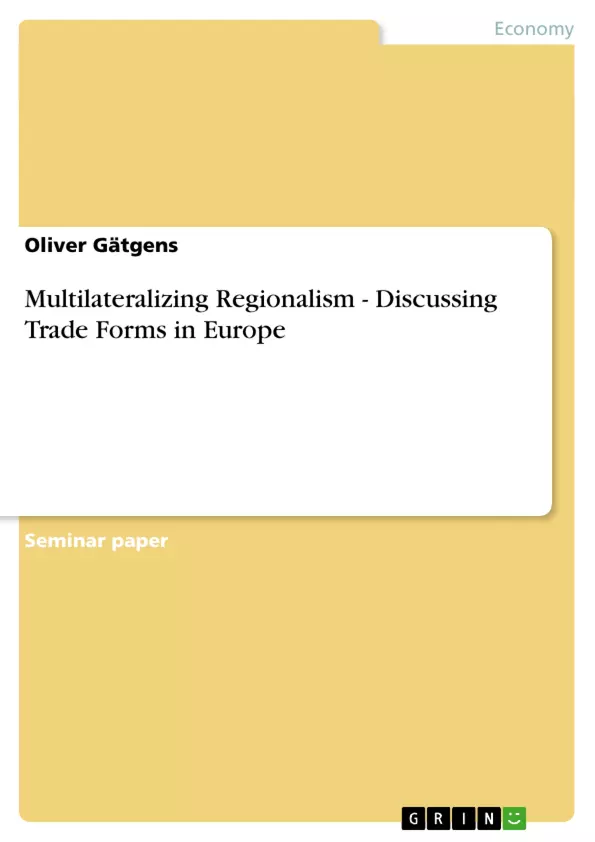In chapter two we saw three main effects of trade liberalization: Juggernaut, domino and race to the bottom. The multilateral Juggernaut effect uses the principle of reciprocity to explain that a final tariff of zero is possible when all goods are traded and negotiation is held long enough. Domino effects on a regional base occur, when countries find it political optimal to lower the tariffs which they earlier found to be protect worthy. An early participation in the RTA prohibits from losing connection in inter-national manufacturing diversion. Domino hereby means that outsider want to join, when other countries previously joined. This leads to the basic assumption: Be the first and be the biggest company to gain cost advantages. Smaller companies will exit through import com-petitors. Unilateral race to the bottom tariff cutting is relevant to Asia and is motivated by the wish to participate from out sourced workload of devel-oped countries...
Inhaltsverzeichnis (Table of Contents)
- Introduction
- Market Liberalization
- Forms of Trade Agreements
- Ongoing: Regionalism vs. Multilateralism
- Reasons and Outcomes of Trade Liberalization
- Unilateral Case
- Multilateral Trade Negotiations and the Juggernaut Effect
- Dominos & Preferential Trade Agreements (Regionalism Case)
- Effects of Trade Liberalization
- Historical Narrative of the 3 Main Effects in Europe
- Europe's Outcome: A Tangle of Diverse TAs
- Europe's Spaghetti Bowl
- Comparing Europe's with Asian Tangle
- Taming the tangle - How to finally reach free trade?
- Conclusion
Zielsetzung und Themenschwerpunkte (Objectives and Key Themes)
This seminar paper examines the process of trade liberalization in Europe, particularly focusing on the relationship between regionalism and multilateralism. It aims to explore the various forms of trade agreements, analyze the reasons and outcomes of trade liberalization, and assess the effects of trade liberalization on Europe.
- Forms of Trade Agreements
- Regionalism vs. Multilateralism in Trade Liberalization
- The Juggernaut Effect and Domino Effects in Trade
- Trade Diversion and Trade Creation
- Europe's "Spaghetti Bowl" of Trade Agreements
Zusammenfassung der Kapitel (Chapter Summaries)
- Introduction: This chapter introduces the topic of trade liberalization in Europe, emphasizing the ongoing debate between regionalism and multilateralism as approaches to achieving free trade.
- Market Liberalization: This chapter explores the various forms of trade agreements, including unilateral, bilateral, regional, and multilateral agreements. It discusses the reasons and outcomes of trade liberalization, focusing on the concepts of the "Juggernaut Effect" and "Domino Effect" in the context of trade agreements.
- Effects of Trade Liberalization: This chapter examines the historical development of the three main effects of trade liberalization: trade creation, trade diversion, and the creation of a "Spaghetti Bowl" of trade agreements. It analyzes the specific case of Europe's "Spaghetti Bowl" and compares it with the "Noodle Bowl" of Asia.
Schlüsselwörter (Keywords)
This seminar paper focuses on the key concepts of regionalism, multilateralism, trade liberalization, trade agreements, trade creation, trade diversion, the Juggernaut Effect, the Domino Effect, and the "Spaghetti Bowl" effect as applied to the European context.
- Arbeit zitieren
- Oliver Gätgens (Autor:in), 2011, Multilateralizing Regionalism - Discussing Trade Forms in Europe, München, GRIN Verlag, https://www.grin.com/document/199571



